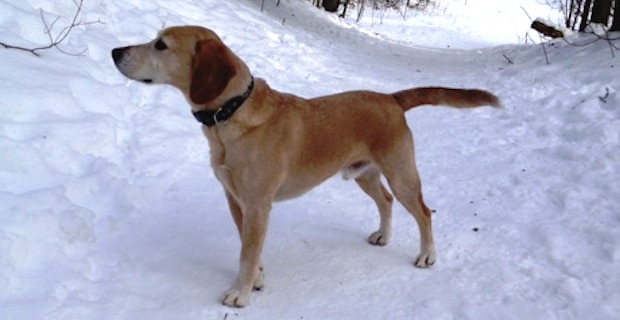
Meet Ranger: He’s the newest tool in mold detection, and I was lucky enough to see him in action on my recent interview with indoor air pollution expert Frank Haverkate. Frank is an environmental consultant and founder of SafeAir.ca, and he's the first Canadian air quality expert to use a mold detecting dog (a practice he started in 2003).
Ranger detects mold growth that results from moisture buildup. He was professionally trained at the Florida Canine Academy to specifically detect mold. And the best part? Ranger and all the other training dogs come from the Florida Humane Society so it doesn’t matter what breed they are as long as they can make it through the training. Unfortunately, many dogs don’t make it through, but they are re-adopted back out to other lucky dog lovers. It’s a win-win situation. The dogs were first trained to detect arson, drugs, and bombs, but when trainers realized that mold could also be detected through scent, they started training mold dogs.
Read more tips for reducing bathroom mold
Eighty percent of mold issues in the home are hidden, and even if you detect mold, it’s hard to pinpoint it. Ranger is taught to follow the scent of mold and identify it through a “passive alert,” meaning he shows Frank where the mold is by sitting next to the affected area, rather than barking or scratching.
I watched and learned as Frank evaluated the air quality at a Toronto home with Ranger in tow. It was fascinating. First, he used a thermal imaging handheld device to look at moisture in the air and behind the walls where we can’t see it. The thermal imaging device looks almost like a video game or a handheld computer, and the colors begin to change when moisture is detected. If moisture shows up behind a wall, Frank uses a moisture meter to evaluate the amount of moisture detected. Moisture in a wall cavity can lead to mold later on, which in turn, can make the air dangerous. There are over 200,000 types of mold: some harmless, some that can cause allergies, and some that can be very harmful. So it’s best to know what you’re dealing with.  I got to watch as adorable Ranger went straight to work in the basement and sat right beside an area where Frank had detected moisture buildup. Using his incredibly adept sniffing abilities, Ranger can do what humans cannot, pinpoint mold and show that moisture buildup has moved beyond just moisture and developed into actual mold.
I got to watch as adorable Ranger went straight to work in the basement and sat right beside an area where Frank had detected moisture buildup. Using his incredibly adept sniffing abilities, Ranger can do what humans cannot, pinpoint mold and show that moisture buildup has moved beyond just moisture and developed into actual mold.
Frank also uses a combination of handheld equipment to identify other potential air pollutants like dust and chemicals – including VOCs, in the air. After identifying what’s in the air, lab testing shows whether the substances include mold spores, dust, and other particles that are dangerous to inhale. Frank can also identify the chemicals in the air and find out if they’re at safe or dangerous levels.
I had the chance to talk to Frank and learn more about his fascinating business. Feel free to watch the video below, or if you are pressed for time, we summarized some quick points below. If you want to see Ranger in action, skip to 8:32 (he is super cute).
Andrea Donsky: Why is indoor air quality so important?
Frank Haverkate: We spend about 90 percent of our time indoors, and indoor air quality can be up to ten times more polluted than outdoor air. Bad air quality can be caused by volatile organic compounds, also known as VOCs (carbon-based chemicals), chemical off-gassing, water damage, mold growth, chemical cleaners, heating equipment, dust, housing mechanics, poor ventilation, and furniture.
Andrea Donsky: How do you know if your air quality is poor, or even dangerous?
Frank Haverkate: Side effects of poor indoor air quality can include flu-like symptoms, headaches, respiratory issues, and skin rashes, or perhaps you’re having trouble recuperating from an illness because your immunity is low. Our own physical health is one of the first indications that the air quality isn’t what it should be. Air quality impacts different people in different ways depending on our own immunity and the places where we’re most vulnerable. Wintertime condensation, weird odors, or a history of flood, leaks, and toilet overflows leading to mold growth are also indicators that the air quality could use some special attention.
Andrea Donsky: Is there anything that we can do on our own to improve air quality at home?
Frank Haverkate: Without knowing exactly what the issue is and what needs to be done, it’s difficult to remedy the situation. For instance, you could buy expensive filtration equipment and find out later that wasn’t the issue. Just like you would go to a doctor before taking a bunch of pills, you need an air assessment to find out what specifically, if anything, is wrong with your air.
There are many ways in which you can be proactive when it comes to indoor air quality. For example, choose VOC-free paint when painting your house, plant-based cleaners, a high quality AC filter, and furniture made from natural materials (that don’t off-gas). In addition, avoid excessive carpeting and upholstery, which can be made with chemically-based materials and can collect dust.
Read more about indoor plants and air purification
We breathe in indoor air all the time so it’s something you should definitely take seriously. Let me know if you have any questions for me or for Frank Haverkate in the comments below.




